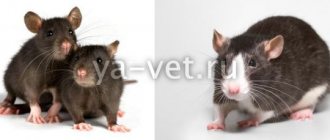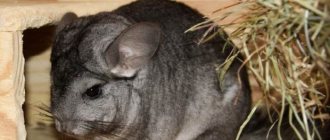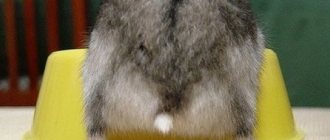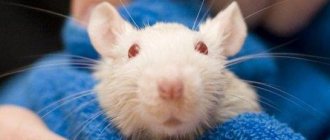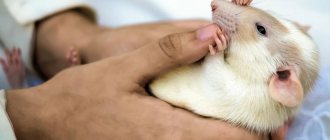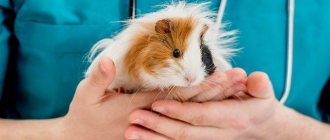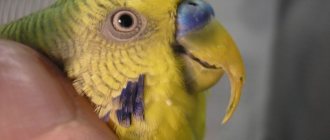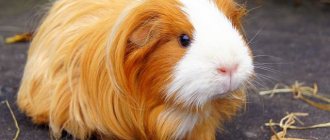Symptoms of constipation in chinchillas
Depending on the severity of the disease and its duration, the symptoms may change, but the main ones will always be the same.
- Boluses (feces). Using them, you can identify many diseases in a chinchilla and make a diagnosis. During constipation, the chinchilla's boluses become smaller, and they can decrease gradually by 1-2 mm, or they can sharply decrease by 2-3 times. Sometimes constipation is so severe that boluses may be completely absent and an urgent visit to the veterinarian is necessary.
- The chinchilla's activity drops sharply, but this usually manifests itself on the 2-3rd day of constipation.
- Gradual refusal of food. At first, the chinchilla simply eats less, but this is difficult to notice. Usually, owners notice when the animal completely refuses to eat.
- If your chinchilla is in pain, it may squeak slightly. This means that the disease is rapidly progressing or advanced, and urgent measures must be taken.
- Weight loss. This is difficult to notice, and besides, in 2-3 days she will lose almost nothing.
- During constipation, the abdomen is usually hard and distended. But this is not the main indicator of constipation; it is much more important to look at the size of the boluses. Because a hard belly can mean bloating.
If you cannot clearly identify the symptoms and make sure that it is definitely constipation, then you need to contact your veterinarian. Otherwise, you may treat your chinchilla incorrectly, which could result in new illnesses or the death of your pet.
By the way, if you have 2 or more chinchillas, then you need to remove the individual that shows external signs of illness, and only then make sure that it is really her, and not her neighbor, who is suffering from constipation.
The most common diseases and tips for their treatment
By nature, these animals have developed a very strong immune system, so they do not need any vaccinations. But diseases still exist, and it is better to prevent them than to treat them. The main cause of all diseases is poor nutrition. As a result, metabolic disorders occur, immunity decreases, kidney destruction and tooth loss occur, and eye diseases also occur in chinchillas . A proper diet will minimize the possibility of illness. The most common diseases:
- eye disease in chinchillas
- diarrhea
- excessive salivation (bad breath)
- constipation
- inactive animal
- inappropriate behavior in an animal
If such symptoms appear, you should consult a specialist.
Causes of constipation
Constipation is not a separate disease; it usually accompanies or is caused by another disease. It is very important to find out the cause of constipation in a chinchilla in order to carry out proper treatment, and then get rid of the source of constipation and carry out prevention in the next couple of months.
The main causes of constipation in chinchillas:
- Wrong diet. A lack of any food or an excess of it can cause constipation. For example, very often constipation occurs due to the lack of hay, which acts as an aid to digestion.
- A sudden change in the brand of food or switching to homemade food. Chinchillas love to eat the same food; for them, the process of switching to something new is very difficult. It is necessary to introduce new food gradually, mixing it with the old one. It is also worth paying attention to the food that some chinchilla owners make with their own hands; perhaps you made some mistake and you should return the old food to the animal.
- Lack of water or broken drinking bowl. Sometimes it happens that the valve of the drinker becomes clogged or simply becomes unusable, in which case it stops working and chinchillas are unable to consume enough water. Therefore, when changing the water, check its performance.
- The cause of constipation may be another disease, the symptoms of which may be invisible, or the disease has passed, and constipation has become its consequence.
- Infections that disrupt processes throughout the gastrointestinal tract.
- Lack of movement. The chinchilla must move, but some have too small cages and the animal spends a lot of time sitting, which also often causes constipation.
- Constipation can occur due to medications you have previously given to your pet.
- An overabundance of treats. There may be so many treats that the animal stops eating its main food and hay, and without it normal digestion is impossible. Or some delicacy caused poisoning, bloating or liver problems, hence constipation.
- A foreign object enters the stomach. Most often, this is hair that has gotten caught in the lump and interferes with normal digestion.
- Stress is often a cause of constipation, but most often it occurs when a chinchilla has just been bought and they begin to forcefully handle it without first taming it.
The most common cause of constipation in chinchillas is an improper diet. This means that the chinchilla has a deficiency or excess of some ingredients.
Whatever the healthy food, the chinchilla should always have a lot of hay in the cage. Hay is a "vehicle" in chinchillas' digestion, so a lack of it can easily cause constipation.
Inactivity is also a common reason, but there are only 2 options why she doesn’t run much. Either you are not giving her the opportunity, or she has developed a serious illness that has caused her to lose her energy.
Constipation can be caused by another digestive disease, so if you are experiencing it for the first time, it is best to take your pet to the vet.
Toilet filler
You can use finely granulated charcoal or sawdust as a sanitary tray filler. You can purchase these materials at pet stores. The most commonly used universal filler.
When purchasing, you need to clarify the composition of the material. It is not advisable for chinchilla litter to contain sand or hay. The sand bath is used by the animal to hygienically clean the fur, and the animal may confuse the trays.
Constipation in a chinchilla: what to do, how to treat
First of all, you need to make an accurate diagnosis. If you are not sure that it is constipation, then you have only one option, take your chinchilla to the vet. Constipation is a dangerous disease and should not be underestimated. If treatment is delayed, the pet can quickly die because one of the most important functions in the body – digestion – is disrupted.
Next, you need to establish the reason why chinchillas have constipation, in order not only to treat it, but also to avoid its recurrence. Make sure you give her quality food, plenty of hay in her cage, and no problems with her water bottle. During treatment, it is necessary to change the diet, which should be dominated by foods that have a laxative effect.
Treatment of constipation in chinchillas step by step:
- An animal with constipation should live separately so that treatment is carried out correctly and quickly.
- There should be nothing in the cage except hay and clean water. If the pet refuses to drink, then it is necessary to lubricate the drinking bowl with honey, raisins, etc. If this does not help, then you need to give the animal something to drink through a pipette or syringe. If there is not enough water in the body, the feces may dry out, causing part of the intestine to die and the animal to die.
- During constipation, saline solution is injected, about 15-20 ml per day. This should only be done under the supervision of a veterinarian.
- Now you need to decide how to treat the animal. There are traditional methods that are very easy to implement and do not require any costs. You can also resort to treatment with medications that can be purchased at any veterinary pharmacy. Read the instructions below for treatment with both options and choose the one that suits you best.
Refusal of the animal to go to the toilet in the tray
There are situations when a chinchilla refuses to go to the toilet in a specially designated place. This can happen for several reasons:
- manifestation of character. Chinchillas are capable of being harmful and, contrary to the wishes of their owners, relieve themselves on the floor of the cage. This can happen in situations where the animal feels psychological discomfort, for example, constantly hears sharp loud sounds that it extremely dislikes;
- urine shots. Females often practice this behavior when they are dissatisfied with the behavior of their owners or feel antipathy towards the male. They do this at night, so owners can see the results of their pet’s dissatisfaction by splashes on the walls or floor next to the cage. In this situation, it is necessary to take measures to eliminate the negative factor, for example, transplant the male into another cage;
- marking the territory. This behavior is observed in adult males when a new individual appears in the inhabited territory;
- the taming process was not carried out correctly. If the animal does not understand where its toilet is, it will need to be trained several times. You will need to repeatedly sprinkle the puddle with filler and move it to the tray.
Also, the animal may not go to the toilet if there is dirty litter and the entire cage is covered with its particles. The animal may think that the litter box is everywhere because the litter indicates this. For the training process to be successful, you need to arrange the cage comfortably and regularly clean it of animal waste.
Usually, toilet training occurs during the adaptation period, when the animal has just appeared in the family, so the animal does not always remember the place allocated for special needs from the first day.
Traditional medicine for the treatment of constipation in chinchillas
Normal constipation without complications and neglect can be easily solved by feeding prunes, petroleum jelly and dried apricot compote (without sugar).
For constipation, it is necessary to feed and water the chinchilla with laxatives of traditional medicine. A decoction of flax seeds works well; for humans it gives a very mild laxative effect, and for chinchillas it is a very powerful medicine. If constipation is mild, then using a decoction of flax seeds will cure it 100%.
Decoction recipe: Take 2-3 tablespoons of flax seeds per 200 ml of water. Boil the broth for 10-15 minutes, and then leave to infuse for 2-3 hours. It is better to steep the broth until it becomes viscous, like weak jelly. Next, the broth must be passed through cheesecloth, and the seeds can be thrown away. The decoction should be given 3-4 times a day with a break of 2-3 hours. You can give the decoction from a spoon, but if the chinchilla refuses to drink it on its own, you can give it to him using a syringe. For 1 dose you need to give 3-5 ml of decoction.
If folk remedies do not give any result, and even worse if there are no boluses at all, then you must urgently contact a veterinarian so that he can prescribe the correct treatment for constipation.
Where to put
When choosing a location for the tray, you should follow the recommendations:
- The toilet container should not be placed too high. A chinchilla will not climb on shelves to relieve itself. The best place is the bottom of the cage.
- If possible, you can purchase a structure with a roof. Although not all animals agree to climb into a hole to do toilet chores.
- Move the drinking bowl, feeder and toys to the opposite corner of the cage.
- When installing a toilet, you need to make sure that there is no bright lamp, noisy TV or radiator nearby. All this will prevent your pet from relaxing and focusing on the main thing.
If a chinchilla constantly changes the place where it relieves itself, or randomly uses the bottom of the cage, then the feces are scooped up in one place and left there for a while.
Treating constipation with medications
If your chinchilla does not poop after using natural laxatives, it is best to consult a veterinarian. In case of severe constipation, it is necessary to check the intestinal permeability. To do this, take simple Vaseline oil and drop one milliliter into the animal’s mouth with a syringe every two or three hours. The procedure is stopped when oil begins to come out from the anus. The use of oil is not a solution to the problem, it is only one way to alleviate the animal’s condition and make sure that the intestines do not have severe congestion or volvulus.
A more alarming symptom is that the pet does not poop, refuses any food offered, and does not drink. It is necessary to give a subcutaneous injection of two milligrams of a five percent glucose solution and eight milligrams of saline twice a day. You can also add half a milliliter of Veracol or Liarsin. The injection will support a weakened body and protect against exhaustion and dehydration. It would also be a good idea to give an injection of Catozal - 0.5 - 0.8 ml, and continue to feed the animal from the syringe.
To treat complex constipation, the following are usually used:
- Five drops of Regulax per one hundred milliliters of water, soldered from a syringe,
- Five drops of Duphalac through a syringe, repeat every 12 hours until visible improvement,
- Vetom 1.1. The probiotic is given as prescribed by the veterinarian.
- Vetom 1.1. can also be used after eliminating constipation to stabilize the functioning of the entire intestine. The drug is given twice a day for a week.
Constipation, which is accompanied by bloating, is more effectively treated by:
- Sab Simplex - 0.5 milliliters two to four times a day,
- Timpanol - as prescribed by the doctor.
Sometimes Espumisan helps. However, before using it, it is better to consult a doctor.
A very useful video for those who do not know how to properly give medicine to a chinchilla. It is especially useful for those who treat constipation, since chinchillas have practically no appetite at this moment.
You can alleviate the animal’s condition and stimulate intestinal function with the help of massage.
Do it in a circular, soft motion from the chinchilla's breast to the bottom of the tummy. The procedure takes up to three minutes and is repeated up to ten times a day.
Constipation cannot be treated with enemas or activated charcoal. All these procedures can bring visible temporary relief and after a short time turn into serious complications.
After intestinal function has been restored, it is necessary to establish a proper and balanced diet, but return the animal to food gradually. This is especially important for animals that have not eaten for a day or two. A large load on the stomach and intestines can lead to various serious consequences. It is also necessary to ensure the constant availability of clean and fresh drinking water. Active movement will be a good help to restore normal bowel function. The chinchilla needs to be let out more often or buy new cage toys.
Tray selection
The chinchilla is a very clean animal. The advantages of the rodent include an attractive appearance, lack of shedding and unpleasant odor. Therefore, installing a tray in a spacious cage will be an excellent solution for those who want to save their home from the smell of urine and excrement.
In the wild, chinchillas look for secluded corners for toileting. It's worth taking advantage of this. A tray with filler in the farthest corner of the cage will help the rodent learn to relieve itself there.
It is best to pour sawdust or charcoal into the tray. Hay and sand are not suitable for these purposes - a rodent will definitely swim in the sand, but the hay will simply eat it. Sawdust or charcoal can be purchased at a pet store. To avoid an unpleasant odor, the filler in the container must be changed daily.
The animal's toilet can be purchased at a pet store; it can be made of plastic, tempered glass or durable ceramics. You can also use an old plate, glass container or baking dish as a pot. The edges of the product should not be high. There should be enough space so that the pet fits entirely, and there is still some free space left.
It is important that the structure is stable. Having turned it over once, the chinchilla will no longer go into it.
The tray should be placed in the far, dark corner of the cage. If an animal goes to relieve itself in a certain place, then you should follow its lead by placing a container there.
Preventing constipation
Prevention is always easier than cure, as any doctor will tell you. Premium food contains additives that normalize digestion and help it, but if you do not have the opportunity to feed it to your chinchilla, then you need to do prevention yourself by adding components that are useful for digestion to the diet.
The main thing is not to forget that there should be an unlimited amount of hay in the cage; the chinchilla eats it only in the amount it needs. It pushes food through the intestines, and accordingly plays a very important role in digestion. Its absence can very quickly provoke constipation.
It is also worth remembering the list of prohibited foods to avoid digestive problems:
- Branches, bark and leaves of prohibited trees. The list is quite large, read it in a separate article. The main thing to remember is that you should not feed oak, coniferous trees or cherries.
- Fresh vegetables, fruits and herbs. In fact, they can be given, but only in very limited quantities and you need to know what exactly is safe to feed.
- Limit the number of treats, especially nuts and seeds. They are very fatty and it is difficult for the chinchilla to digest them, since she has a weak liver.
- Do not give fermented milk products under any circumstances, they are very dangerous and cause bloating.
- Legumes are also prohibited as they cause bloating. It is forbidden to give peas, lentils, as well as leaves and stems of legumes.
- You should not give salty, fried, sweet and especially fatty foods. No food from your table should get into their cage, even dried bread.
- Beets, cabbage, fresh peppers.
How to recognize the disease
Symptoms of this disease can develop from several hours to several days. If the disease develops over a long period, you will be able to see that the boluses become small and there is a possibility of dysbacteriosis developing. This can often be due to an infection or infestation with parasites. It is important to remove not the symptoms, but the cause of the malaise.
The symptoms are as follows:
- There are fewer boluses, they are smaller.
- The animal has not pooped for several days.
- Heavy breathing is noted.
- Loss of appetite and more.
Among the reasons for this malaise are the following:
- The diet contains sweet foods in large quantities. In this case, the boluses may smell like fermentation products.
- Long-term use of antibiotics may lead to difficult bowel movements.
- Not drinking enough.
- Entry of foreign objects into the stomach.
- A large amount of hay in the diet.
- Low quality food, unbalanced diet.
- Disease of organs such as the liver and stomach.
Symptoms and manifestations
Spastic constipation is quite easy to recognize. Doctors Shulpekova Yu. O. and Ivashkin V. T. describe it as follows: “Constipation is spastic in nature, when the tone of some part of the intestine is increased and feces cannot overcome this place. Feces take on the appearance of sheep” (Shulpekova, Ivashkin, 2004, p. 49).
Unlike atonic ones, these forms of constipation are less likely to be prolonged; stool retention lasts no more than 2–5 days. Stool can be daily, but fragmented and in a very small volume.
Associated symptoms may include the following:
- pain and cramps in the abdomen;
- bloating, increased gas formation;
- false urge to defecate;
- feeling of heaviness in the stomach.
Pain and discomfort can be localized in different parts of the abdomen, it all depends on which part of the muscle is in spasm, where exactly there is an accumulation of dense feces and gases. Therefore, a symptom of spastic constipation may be pain in the side on the left or right, in the lower abdomen and in the epigastric region.
There are also nonspecific manifestations associated with intoxication of the body: nausea, headache, dizziness, increased sweating, pale skin, fatigue, decreased performance, irritability.
Prevention of diarrhea during antibiotic therapy
To prevent diarrhea while taking antibiotics, it is important to follow several recommendations:
- strictly adhere to the dosage and treatment regimen prescribed by the doctor;
- use probiotics recommended by a specialist;
- follow a diet to prevent gastrointestinal disorders;
- maintain optimal drinking regime;
- take medications that protect the lining of the stomach and the entire digestive tract. If you have chronic ailments, you must inform your doctor about them so that he can select an individual scheme for protecting the digestive system from the effects of antibiotics.
If it is necessary to take antibiotics, it is important to take into account the body's previous reactions to antibacterial therapy. Thus, in some patients, antibiotic-associated diarrhea develops in response to exposure to a particular group of drugs or a specific agent.
